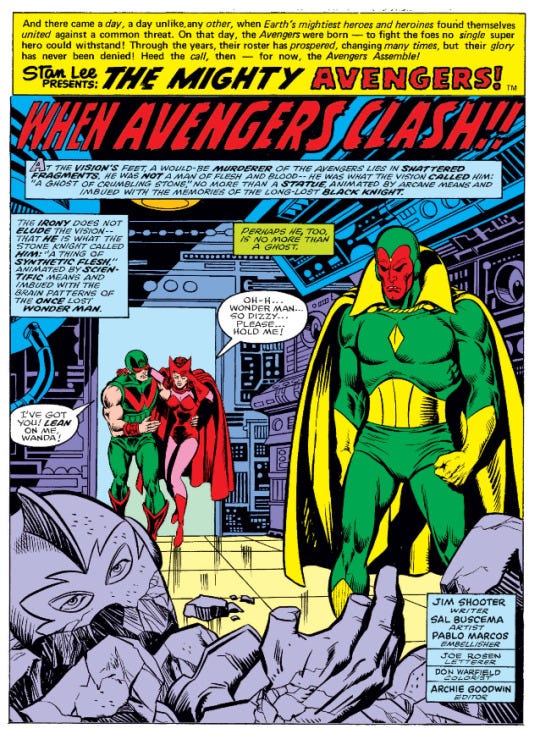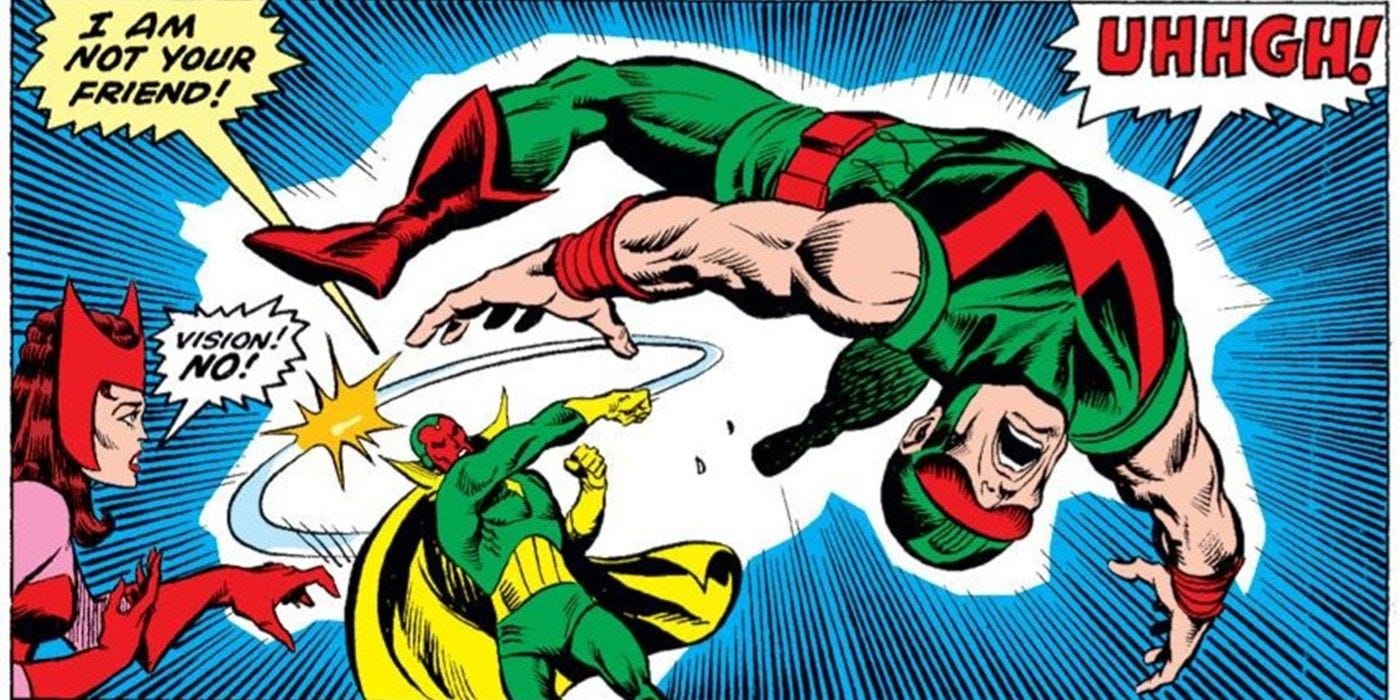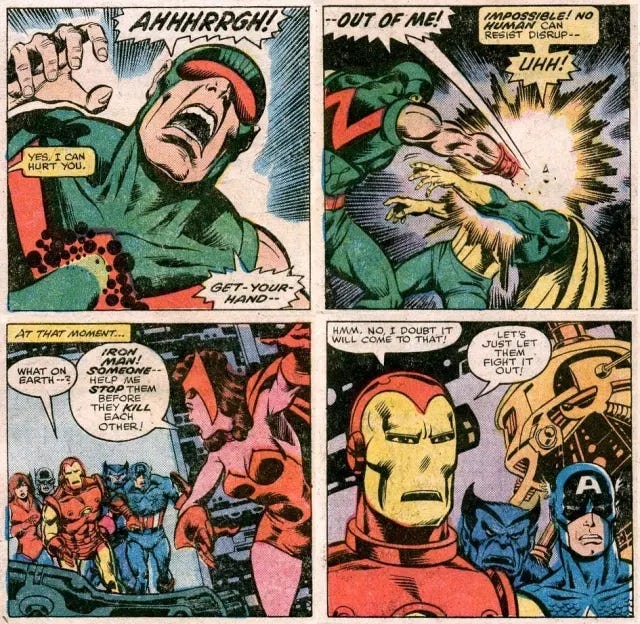First of all, I don’t profess to be a critic. Hell, I don’t want to be a critic. Hence, this is absolutely not a review. This is an exploration. Possibly a bit of an excavation. Certain comicbooks -- like this one -- are a deep part of my DNA. And so now I’ll attempt to discuss exactly how -- and possibly why -- they got there…
AVENGERS #158
“When Avengers Clash!!”
Jim Shooter – writer
Sal Buscema – artist
Pablo Marcos – embellisher
Archie Goodwin - editor
With a cover date of April 1977, I probably got this comicbook in winter of that year, either January or February (a cursory bit of research tells me this was released on January 18, but back then that didn’t really matter like it does now). Odds are it was purchased for me -- by my mom, most likely -- off the spinner rack, at the old Jim Dandy convenience store (now known as the Brentwood Market) on Franklin Road. I would’ve been six years old. This was before the Direct Market, at least as far as where I was living at the time. This issue sported a Jack Kirby cover years before I’d learned to fully appreciate Kirby’s work. But even now, I feel like it’s just… okay. Gets the job done, though.
After a handful of random “script only” appearances in the credit box over the previous months on the title (providing dialogue over Gerry Conway’s plots), this is the first issue written top-to-bottom by Jim Shooter. His run on this title is incredibly well-regarded (by myself and many others). But… why? Is it just a generational thing? I was certainly young enough to be impressionable as hell when this run first hit newsstands. Or is there some secret sauce that Shooter possessed that perhaps set him apart even from other, equally accomplished -- and in some cases, revered -- Avengers writers? Let’s find out…
Aside from the youthful enthusiasm of a young George Pérez (who latched onto the Avengers gig as an early assignment like a man possessed), the party line on team books was that artists would avoid them like the plague. Too much to draw. Too many characters. Too much work for the same page rate that an artist could make on single hero series like Spider-Man or Iron Man (keep in mind, this was before the existence of any sort of sales-based royalty program). But now I wonder if the same was true for writers?
My impression now is that this was a job for Shooter, that his priorities lay mainly in being a professional, in delivering professional-level work. He seemed to have a certain amount of emotional distance from the material. Certainly more than other second generation “fan-turned-pro” writers that were among his peer group (of which I would include Roy Thomas, Gerry Conway, Steve Englehart, Marv Wolfman, Len Wein and others). The other difference is, Shooter had already been doing the job -- off and on -- for almost ten years at that point. He famously began his career at fourteen years old selling Legion of Super-Heroes stories to DC Comics. And he did it not just because he loved comicbooks, but because his family needed money. I won’t even bother getting into the possible psychological ramifications that resulted in his primary editor at DC being the infamous Mort Weisinger (if you’re not familiar with Weisinger, look him up. Don’t say I didn’t warn you…).
Additionally, I’m not sure if Shooter shared in the “doom and gloom”-mentality that many professional comicbook pros seemed to have at that time. Historically speaking, the mid-1970’s were pretty grim for newsstand periodical comicbooks. By many accounts, a lot of folks in the biz thought it was just a matter of months before the whole industry collapsed in on itself. And when Shooter began his Avengers run, it was right before Star Wars (the comicbook adaptation of which, by Shooter’s own admission, basically saved Marvel Comics as a company). Anyway, this preamble is just to provide some possible context for how Shooter wrote the series.
The first page captions bring us right up to date, in terms of story. But also in terms of mood. They’re not written in the faux Stan Lee-style that both Roy Thomas and Steve Englehart -- acknowledged by fandom even then as the two greatest Avengers writers -- excelled at. Reading it now, there’s definitely some sense of a stylistic break from Thomas and Englehart… albeit a subtle one. To me, it’s a different version of the patented “Marvel soap opera”-type of writing. There’s much more gravitas on display here, without any of the nudge-nudge, wink-wink asides to the readers that previous writers would routinely employ (again, lifted directly from Stan Lee). And if Shooter was trying to emulate the previous, signature Avengers writers in any way whatsoever, he was still doing it his way, using a different narrative voice.
One could also assume that Shooter had free reign on this book, but maybe he was consciously setting some kind of baseline standard of storytelling (since it wouldn’t be long before he assumed the Editor-In-Chief position and began implementing line-wide changes in how Marvel Comics were generally written… by everyone). On Avengers, perhaps he felt he had to lead by example.
On the art side, Sal Buscema would probably be considered a “guest artist” at this point (having put in longer, more significant tours of duty with both Thomas and Englehart earlier in the series). Being inked by Pablo Marcos provided a unique look for Sal’s pencils. Very different from what informed readers would’ve been used to seeing from Sal in the mid-70’s. Marcos gave him more detail and definition. Kind of a middle ground between Vince Colletta’s inks (on Captain America) and Klaus Janson’s inks (on Defenders). It’s a solid, dependable art job with occasional flashes of bona fide visual drama. And no one drew a punch that knocks someone completely off their feet like Sal did…!
The (slightly contrived) opening fight between the Vision and Wonder Man is basically a demonstration of abilities, especially for the Vision. The scene is practically built as a showcase for his various and wide-ranging superpowers. I don’t recall if the “hero-vs-hero” trope was ever something that I particularly connected to as a young reader. But it was a dynamic that Shooter would often return to during both his Avengers runs.
But reading it now, there’s a sense that these two adult heroes are… well, behaving like children. If I really stop to think about it, I suppose I could justify it on a character level. After all, Wonder Man had just recently come out of a years-long coma, so maybe he’s still readjusting to being revived? And the Vision… well, technically he’s only been “alive” for just a few years at this point (if not less, in Marvel Time). So his occasional temper tantrums (this wasn’t his first instance -- nor would it be his last -- of succumbing to an angst-filled outburst) could be chalked up to a lack of maturity due to a lack of learned life experience? Fair enough. I can buy that. Not to mention, he did end up marrying his first girlfriend…
But, more than that, I have to stop and consider whether or not this kind of hero-fights-hero trope is a conscious choice on Shooter’s part to be relatable to the readership… which was predominantly kids like me. Kids fight all the time. Even good friends would get into physical scrapes on a fairly consistent basis. Especially young boys. At least, that’s how it was forty plus years ago, quite a bit before the helicopter parent syndrome really took hold. In any case, there’s something strangely… recognizable in the notion that the Avengers would occasionally throw down with each other.
From a pure craft point of view, it also reads a little like Shooter is still getting to know the characters, right there on the page. It’s a fascinating thing for me to see now, after having done the job myself for longer than Shooter had when he wrote this comicbook. And in this issue, I would say he’s not quite there yet, at least with some of them, so maybe he’s treading water with an action scene. In particular, the Scarlet Witch’s characterization is weak sauce, with Shooter unfortunately veering into stereotypical “slightly hysterical female” territory. She deserved much better.
As for the other Avengers (once they actually show up), Iron Man inexplicably suggests that they should let them “fight it out”, seemingly ignoring the fact that these are the two most powerful Avengers battling each other inside of a mansion located in the heart of Manhattan! I mean, if things get really out of control, they could destroy the city, right? But, sure, why not let ‘em go at it? And so he does. For a page. Finally, sanity prevails and he puts a stop to the brawl.
Iron Man has a few thoughts on the state of the team: “Is this what the Avengers have come to--?” Then, in the same panel, declares out loud, “I’ve got a few things to say!” Presumably he’s basically going to voice the same insights we just read in his thought balloon, but the scene cuts and we never see that speech… which I really would’ve liked to read! I remember, as a kid, being completely fascinated by scenes like this. Is this how adults relate to each other when kids aren’t around?
This issue also gives us the debut of the villain, Graviton. His intro is a mini-soap opera unto itself. Four pages of set-up, character dynamics and origin flashbacks. Quite the narrative detour for a superhero comic at that time. Then the Avengers show up. Why they show up is due to a small plot detail that occurs off-panel (although it’s referenced almost in passing during the previous scene by the Avengers’ butler, Jarvis), and could’ve easily been lost on a younger reader (as I’m sure it was on me when I first read it). Personally, I think the fact that Graviton raised a big chunk of land into the air (think Ultron’s final gambit in the second Avengers movie) would’ve been enough to get any superhero’s attention, but the way Shooter writes it at least squeezes every bit of juice out of that stone (so to speak).
Quick aside: When the Avengers arrive, Cap yells, “Avengers attack!” as opposed to the traditional, classic, “Avengers assemble!” battle cry. WTF? Interesting choice on Shooter’s part.
The fight with Graviton is pretty standard fare. Superheroes shooting stuff and throwing punches. Even as a kid, fight scenes were never my favorite bits (although I’m sure I was in the minority there). But there is a very cool moment when Cap’s shield is crushing him due to Graviton’s power. Thanks to Sal’s art and Cap’s tiny “Can’t… breathe…” word balloon, that panel contains both drama and power in equal amounts…
The end of the issue is a literal cliffhanger (cue rim shot). Upon defeating the Avengers, Graviton states his intention to… well, rule the world. Sigh. Yeah, that ol’ chestnut. Even as a kid, I never bought this hackneyed motivation from any super-villain.
As a six-year-old reader, this comic was probably just barely beyond my complete comprehension on several levels. I think Shooter was writing more for ten-to-twelve-year-olds. But the fact that I didn’t get all of the nuance (such as it was) didn’t stop me from getting absolutely hooked in. I wanted to get it. And, y’know, that’s exactly what it was supposed to do. It’s what made comicbooks back then so goddamned great. It’s what made them such a fulfilling experience for readers my age. There were just certain things that went slightly over our heads, but that only served to keep things interesting.
And it sure as hell kept me reading…
Joe Casey
USA











Great post Joe - this was my formative Avengers era as well.
It's funny we were chatting about Graviton on Tom Brevoort's Substack recently and how his generic/lack of motivation was a plot point in Busiek's Thunderbolts run. And how it also prevented him from becoming an A list Avengers villain despite his power set (I always liked his appearance/menace in the OG West Coast Avengers mini by Roger Stern).
Hopefully there will be an “Ask me Anything” or a Q&A at somepoint but I'm just saving these hear for now
Is Sex Vol. 7 forthcoming?
Will you be sharing the Velocity Scripts?
Can you get a little more into how the Wildstorm Universe would have changed if you go to complete Wildcats 3.0?
What would the rest of you Batman and Superman run looked like?
Do you have any approach for the Fifth World?